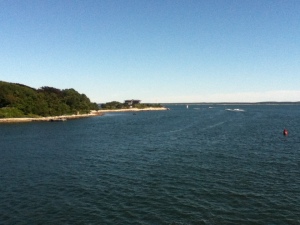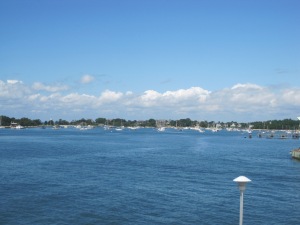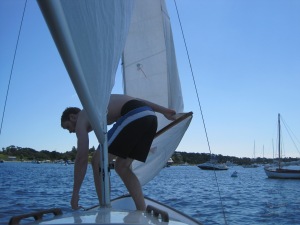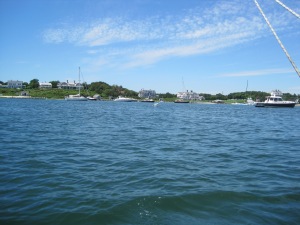It was Sunday afternoon. Dina, Jake, and I had just two days left on Martha’s Vineyard before we were shipped back off to the sweaty politics of a D.C. summer. We had just returned from a smooth sail on Edgartown’s inner harbor. Now it was time for our second trip to the beach. This time we set our sights farther afield than the rocky lighthouse beach that was just fifteen minutes walking from our house in Edgartown. We hopped on our bikes (some with more enthusiasm than others) for a three mile jaunt over to Herring Creek South Beach. The trail took us out of Edgartown, past Ernie Boch and his front yard full of llamas, down Herring Creek Lane, and past the small airport, where small prop planes and gliders swooped around on grass runways.
South Beach was packed with day trippers as usual. And today it was choppy, which made it eminently more exciting than it would have been otherwise. We lay on the beach, jumped in the waves, and Jake and I played catch in the water with a tennis ball. (We developed a game of trying to lead the other with a pass into a wave just as it was curling over. It’s thrilling to have to dive into a wave as it is crashing, trying to catch a small green-yellow ball—like Quidditch, just without that idiot Draco Malfoy.)
That evening, after wearing ourselves out at the beach and dining at the Porthunter in downtown Edgartown, we went for an amble. Jake, Dina and I stopped at Mad Martha’s for some ice cream and then we all strode down to the wharf to see the sun set over the harbor. The dipping globe lit up the clouds of Chappaquidick an exquisite pink and purple, and there was a brief rainbow out over Nantucket sound that framed the lighthouse.
Monday morning was a sad day. Dad left, and he took the puppy with him. That evening the kids were on cooking duty. We decided on a tapas oriented dinner. Dina made an excellent gazpacho, oversaw the creation of backed portobella mushrooms, and architected an excellent caprese salad. Jake did much of the manual labor and made a last minute dash through hazardous traffic to the supermarket. I made a chorizo and red pepper tapa on baguettes. Sadly the only chorizo was Portuguese “chorico,” the flavor was a little too intense and the sausage a little too dry. I also made a red-potato and butter dish, which didn’t fit at all with the tapas, but provided a little American flavor, some starch, and lots of fat.
Tuesday morning—our last day on Martha’s Vineyard—Mom and I went for one more sail. The breezes were light again, but there was enough wind to waft us out to the outer harbor, past the On-Time Ferries, (which considerately waited for our small craft to get through their ferry lane), and the lighthouse, and back in again. Then Jake, Dina and I went back to South beach one more time.
Then it was time to pack up, eat and head over to the ferry. The trip back to D.C. could not have been more different than the trip out. Well-rested, and reasonably well fed, we were wide awake this time. Dina finally got her clam chowder on the ferry back (we never did manage to get her chowder on the island), and despite the long anticipation wasn’t super impressed. Then we hopped on the Peter Pan bus for the two-hour ride to Boston’s Logan Airport. I started the trip with Good Will Hunting in honor of being in Boston, but eventually switched over to Aliens. Jake and Dina took their turn to watch To Kill a Mockingbird, although Jake fell asleep about hallway between the Cape and Boston.
When we arrived in the terminal, forty-five minutes before takeoff, there was no one but a couple of bored but friendly US Airways employees by the check-in. Security didn’t take us more than thirty seconds, and then we were through and at our gate. Dina had to call her mom once we were at the gate, and Jake had to call his job to rearrange his schedule. I had to sit there in an impressive manner and guard the bags. Once official calls had been relayed, we finished off the chorizo tapas we had packed (they turned out better cold), and then it was time to get on board the plane.
I was in the exit row between two other guys. The one in the window seat looked to be in his late twenties or thirties. He spent his entire trip reviewing information and working on a presentation for homeless youth, and spilling the ice cup a stewardess gave him all over his bag. To my left was an older gentleman who sent emails on his smartphone right up until takeoff, then immediately conked out, only waking up to order a Spright zero, chug it, and go back to sleep.
I spent the flight relishing my extra exit aisle leg room and finishing my book, Updike’s On the Farm. The main character gets pulled back on a Sunday evening from the idyllic (if emotionally hazardous) setting of his family farm, to the bustle of New York city. Flying from Boston, away from Martha’s Vineyard, to Washington D.C. I felt I could relate. Then I watched Aliens, and was just getting to the part where the shooting and aliens-eating-marines begins, when the instruction came to turn off all electronic devices. And just like that we were back on the D.C. metro, running back over the Potomac into the heart of The District.







